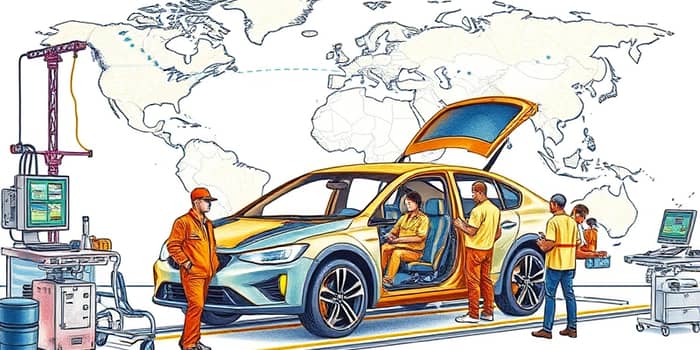
After years of disruption, the global auto sector is entering a period of renewal. The severe global semiconductor chip shortage triggered by the COVID-19 pandemic crippled vehicle production worldwide. Now, as supplies stabilize, automakers, suppliers, and consumers are adapting to a transformed market.
The pandemic’s onset in early 2020 set off a cascade of plant shutdowns and order cancellations. As consumers shifted spending toward home and technology products, chip foundries reallocated capacity, leaving automakers sidelined.
By 2021, output had slumped dramatically. Global auto production fell 26% in the first nine months of that year alone. Factories paused lines, millions of vehicles were delayed, and new model launches were indefinitely postponed.
Analysts warned of prolonged shortages. Yet by mid-2023, chip inventories had recovered enough to support 22 million light vehicles produced per quarter. Looking ahead, experts forecast a modest rebound: a 2% rise in U.S. light-vehicle sales in 2024 and a 3.1% global increase to 91.4 million units in 2025.
“The chip shortage is mostly over, though we expect that some supply chain hiccups may occur from time to time,” noted industry observers. As planners calibrate production, occasional bottlenecks—especially for specialized microcontrollers and analog chips—persist.
Confronted with persistent scarcity, automakers adopted creative strategies to maintain output. Many simplified vehicle electronics, reducing variants and consolidating chip usage across platforms.
These measures protected revenues and preserved customer deliveries. Premium and sport-utility vehicles often took precedence, allowing firms to sustain cash flows while entry-level models faced limited availability.
Component suppliers also ramped up capacity. Major foundries began new fab expansions, though geopolitical and regulatory hurdles delayed some projects. By 2024, improved throughput allowed OEMs to restore features cut during the crisis, improving consumer satisfaction and brand loyalty.
Despite rising production, demand dynamics remain complex. High interest rates and elevated vehicle prices have tempered buying enthusiasm. Many consumers are weighing financing costs against purchase urgency.
Government incentives for EVs persist, but sticker shock and charging availability slow near-term growth. Meanwhile, flexible ownership solutions—such as subscriptions and ride-sharing partnerships—gain traction among urban millennials and Gen Z.
Q&A with several buyers highlights the changing mindset: many value flexibility and minimal maintenance over outright ownership, influencing OEM strategies and marketing investments.
With semiconductor flows largely normalized, automakers plan to boost incentives and discounts in 2024–2025 to move inventory. Yet they retain strong pricing power thanks to controlled inventories, preventing steep declines in profit margins.
Nonetheless, full recovery to pre-pandemic volumes remains elusive. The once-anticipated 100-million-unit global production mark is now projected to slip beyond 2030, as lingering headwinds temper growth.
Geopolitical tensions, extreme weather events, and delays in new fab commissioning could reignite shortages. Observers caution that any significant supply shock—whether from a China–U.S. trade dispute or a natural disaster—would immediately ripple through assembly lines.
“The industry has yet to fully recover, with 2025 expected to bring only modest relief,” analysts warn. They emphasize that resilience depends on diversified sourcing, agile planning, and ongoing collaboration between OEMs and chip makers.
To safeguard against the next crisis, industry leaders advocate several key actions. First, continuing to diversify supplier networks reduces reliance on any single region or fab.
Second, OEMs and foundries must co-invest in advanced process nodes, ensuring access to both cutting-edge and mature chips. Third, enhanced data sharing and demand forecasting will help synchronize production planning across tiers.
These approaches foster a more robust ecosystem, capable of weathering shocks and sustaining growth over the long term. The lessons learned since 2020 are shaping a more collaborative and agile auto industry.
The era of acute chip scarcity is drawing to a close, but the path forward is neither straight nor guaranteed. As production ramps up and inventories rebuild, automakers must remain vigilant against new disruptions.
Consumers, in turn, navigate a landscape of evolving ownership models and advancing technologies. In this period of renewal, allied partnerships and adaptive strategies will determine who thrives and who merely survives.
Ultimately, the auto industry’s rebound is a testament to its resilience and innovation. While the road ahead holds challenges, the current equilibrium offers a launchpad for sustainable, long-term growth and a more secure, diversified supply chain.
References













